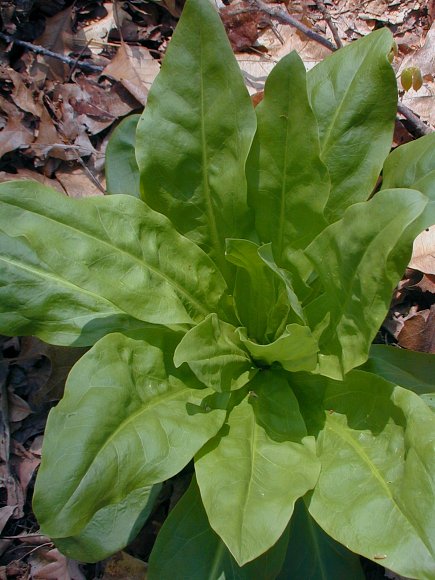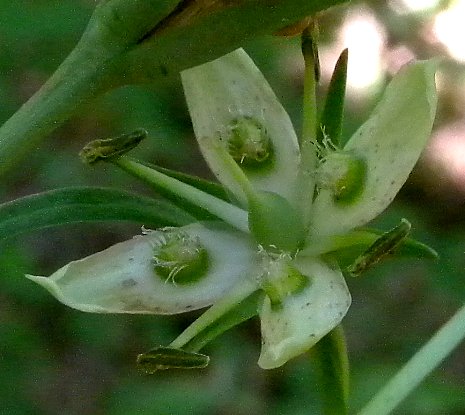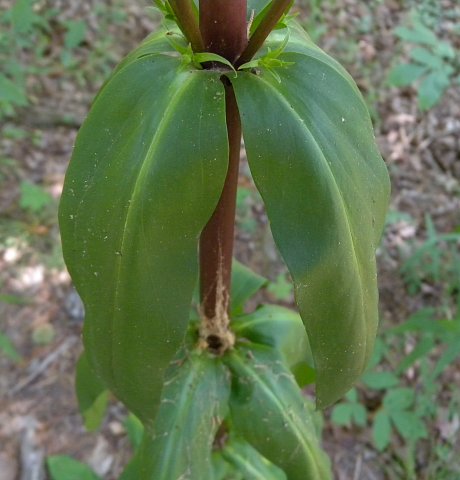
Each flower is ¾-1¼" across, consisting of a shallow corolla with 4-5 spreading petaloid lobes, a shallow calyx with 4-5 spreading lobes, 4-5 stamens, and a superior ovary with a single style. Usually, the flowers are divided into 4 parts, rather than 5. The corolla lobes are oblong-lanceolate or oblong-elliptic in shape; they are mostly greenish white with purple specks or streaks, although their bases may be tinted pale yellow or pale pink. Toward the middle of each corolla lobe, there is a conspicuous nectar pad that is heavily fringed. The bases of these nectar pads are surrounded by rings of green. The calyx and its lobes are medium green and glabrous; individual lobes are linear-lanceolate and up to ½" long. The superior ovary is light green. The peduncle, lateral branches, and pedicels of the inflorescence are light green to purple, glabrous, and terete. At locations where there are divergent branches within the inflorescence, there are pairs of leafy bracts about 1-3" long that are linear-lanceolate or linear-oblong in shape. The blooming period occurs from late spring to early summer, lasting about 3 weeks. The flowers within a panicle bloom at about the same time. Individual plants in a colony have a tendency to bloom synchronically (during the same year at the same time), which facilitates cross-pollination of the flowers. Afterwards, the flowers are replaced by ovoid seed capsules about ½-¾" in length; these capsules are strongly beaked from the persistent styles. At maturity, these capsules become dark brown and split open to release their seeds. Each capsule contains 4-14 dark brown seeds that are crescent-shaped and winged. The root system consists of a fleshy taproot.

Cultivation: The preference is full sun to light shade, mesic to dry-mesic conditions, and calcareous soil that is loamy, rocky, or sandy. The seeds require a dormant period with cool moist stratification in order to germinate. Because this plant persists as a rosette of basal leaves for several years, it is slow to develop, and its seeds are not often available commercially. Problems with disease organisms or insect pests rarely occur.
Range & Habitat: The native American Columbo is occasional in the southern half of Illinois, rare (or possibly extirpated) in NE Illinois, and absent from the rest of the state (see Distribution Map). Illinois lies along the NW range limit of this species. Habitats include upland savannas, upland woodlands, wooded slopes, limestone and sandstone glades, woodland openings, and small meadows in upland wooded areas. In areas near southern Lake Michigan, this plant occurs in similar habitats with calcareous sand. American Columbo is often associated with upland oak trees and such ferns as Asplenium platyneuron (Ebony Spleenwort) and Polystichum acrostichoides (Christmas Fern). It is found in higher quality natural areas.
Faunal Associations: The flowers are cross-pollinated primarily by such long-tongued bees as honeybees, bumblebees, and Anthophorine bees (Anthophora spp.); these insects obtain mostly nectar from the flowers. Aside from these pollinators, there are few records of floral-faunal relationships for American Columbo. The basal leaves of more western species in the same genus, sometimes referred to as 'Elkweed,' are eaten occasionally by elk and other hoofed mammalian herbivores. However, evidence of such browsing hasn't been observed by the author for the more eastern American Columbo.

Photographic Location: A rocky wooded slope in southern Illinois and an upland woodland in east-central Illinois.
Comments: American Columbo is an unusual native plant that has a tall striking appearance when it finally bolts and blooms. The greenish white flowers with purplish specks or streaks have an odd appearance; they are produced in great abundance during the blooming period. Even though the flowers of American Columbo have conspicuous nectar pads like some species in the Lily family (Liliaceae), such as Melanthium virginicum (Virginia Bunchflower) and Veratrum woodii (False Hellebore), it is not closely related to these latter species (the former species is a dicot, while the latter are monocots). The Frasera genus is a small group of plants that are found primarily in western North America. American Columbo is the only eastern species, making flowering plants easy to identity. Immature plants consisting of basal leaves, however, can be confused with the immature stage of False Hellebore. An obsolete scientific name for American Columbo is Swertia caroliniensis.